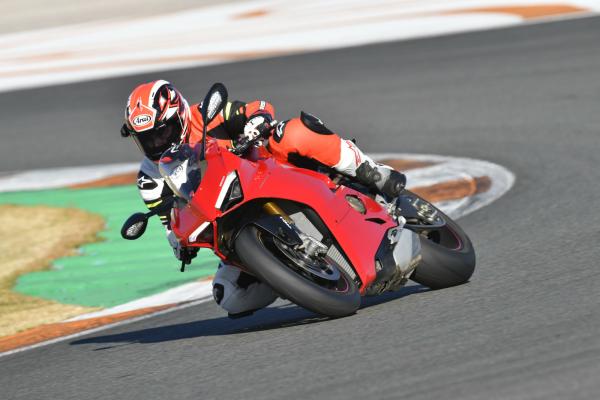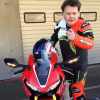
'Another level in superbike performance'
IN life, context is everything. To properly judge something, you need to put it into a bigger picture. Try to work out why it is the way it is – and how it stacks up accordingly. For example, a decent 80p cup of builders' tea from a greasy spoon café is more pleasing than an average £3 mocha from a high street chain.
So I'm considering the context of the new Ducati Panigale V4 very carefully, as I step out of the coach into the car park at Valencia circuit. There's a lot to take in. The first mainstream production V4 engine from Ducati, usurping the 'big V-twin' layout which has made the firm what it is. A startling set of statistics – not least a claimed 214hp - from the bike's unveiling in Milan last year. A cosmetic look which I'm a little unsure of. And a very serious price tag attached to it all – a whisker off £20k for the most basic version.
I'm also factoring in the physical context. Circuit de la Comunitat Valenciana Ricardo Tormo is a place I've been to quite a lot in the past. It's a proper MotoGP racetrack, but it's also quite a tight and nadgery one. When I got the invite for the V4 launch here, I was a bit surprised, expecting Ducati to launch its new big-fast-megabike at one of the world's big-fast-megatracks, like maybe Qatar or Sepang.
Because the stats for the new V4 are pretty amazing.
Ducati's not only made a four-cylinder motor to replace the 1299 V-twin Panigale, it's also given it a hefty displacement boost over the competition.
Where Aprilia, BMW, Kawasaki and the rest have stuck to race-spec 999cc limits, the V4 Pani flips all that the bird, measuring in at a mighty 1103cc. That means 214 claimed hp, in a 174kg dry chassis, with near-Hayabusa levels of torque. Eek.
So what the actual f***? Why is their engine so big? And why are they launching this crazy-assed rocketship at a tight, technical track crammed with nadgery corners? Well, their explanation for the capacity is fairly credible – the engineers say they wanted to retain the massive low- and mid-range grunt of their naughty V-twins, and adding 104cc lets them do that, while getting stonking top-end power too.
And they reckon they've sorted the handling package right out too – so this is no flat-out hp-blaster, but a fine-honed, precision instrument, that can carve the corners as well as it slaughters the straights. There's your context right there journo-man.
Best get on then! We're blessed with the weather actually – my other worry about Valencia was down to the climate: we're in Spain obvs, but quite far to the north. And the third week in January can easily see frozen asphalt and wintry showers here. At the very least, I expected it to be cold first thing. But no – when we kick off at 10am, the mercury's showing a pleasant 16° with not a cloud in the sky. Smart. Kit on, and we're out on the V4 S (we're only riding this version today), following the Ducati test rider round for a sighting lap. Back into pits, then we go out one by one for two warm-up laps.
As ever at this time of year, the first session is about getting your head into the track and rebooting your riding subroutines. From skidding round icy roads in Surrey on my old winter hack Burgman 650, to this – warm, grippy track tarmac, astride the very latest in superbike tech. I had the first and last thirds of Valencia straight in my head, but wanted to sort the middle bit out. Bimbling round, the Panigale feels really forgiving underneath me. The Öhlins electronic suspension is compliant – even feeling a little soft and road-bike-plush at times. The riding position is spot-on for me, and the new colour dash is clear and well-laid-out. In for a quick break then we're out again for a proper session.
With the track layout firmer in my head, I can start to think about the bike. And it's all good news.…
Engine
How does this all-new motor feel when you open it up? Quite special is the answer. There's definitely the feel of a twin low-down: the extra capacity and the 'twin pulse' firing order of the V4 both conspire to give that big twin impression. But it's got a character all its own and, as the revs rise, you have to force yourself not to change up too early. Hang on up towards peak power at 13,000rpm and you get a barking, howling yawl that's utterly seductive. Not that you can pay too much attention to the aural delights mind – the thing is pulling like a fecking rift between alternative universes. It feels like you need to steel your upper body just to stay in this one.
It's not scary though: you feel totally in control at all times, with clean, crisp fuelling, and a real progressive, controllable feel at the twistgrip.
The infield section here is all second and third gear, so it's not until the main straight that you get into fourth, then fifth. Valencia's last turn is notoriously tricky, with a long left-hander that manages to be blind and downhill, before running into essentially a 90° bend onto the main straight. Out of here, drift over to the pit lane entrance, and get the hammer down.
Handling
There's a bit of flapping here from the front end, and once or twice I back off a little before she settles, letting us can get back on it.
Fifth gear comes just after the finish line, and we skip a couple of heartbeats before heaving on the anchors and kicking down to third for the awesome turn one.
We're only out for 15-minute sessions, but as the chequered flag comes out for the first time, I'm feeling a bit beat up already. This bike is so capable, yet makes life so easy that you keep pushing harder and harder in search of a limit. So without realising it, your body's working overtime just to hold on and deal with the forces involved.
I've just about recovered by the next session, and as I fire out of pit lane, I'm thinking a bit more about the rest of the bike. The Pirelli tyres are amazing – Ducati's set us loose on the standard hoops, and for road rubber, the Super Corsa SPs perform amazingly well. There's a new 200/60 rear, and a load of optimised carcass and compound tweaks to give even more grip all round, and considering the torque being hammered through it out of every bend, that new rear doesn’t miss a beat. The front is good too, stable on the brakes, with loads of feel coming up through the Öhlins fork.
Equipment
Of course, none of this should matter, since we have a Bundesliga-level electronics suite looking after us. The latest in cornering ABS, traction control, anti-wheelie and semi-active suspension is all buzzing away behind the dashboard, ready to step in should you need it. The last corner in particular is tailor-made for an old-school litre-bike high-side, and once or twice I feel the hand of the Bosch gods here, guiding me back into line…
The higher-spec accessorised version
As the day wears on, I'm having a proper ball. But there's one more treat in store. Ducati's brought along an accessorised bike – a V4 S, but sporting the official titanium race Akrapovic exhaust system. This, with the associated fuelling changes, means we get an extra 12hp, while losing 7kg of mass. The cherry on the icing on the cake? A pair of Pirelli SC1 superbike slicks…
I'm actually out on this for my last session, so I'm as dialled into Valencia as I'm going to get today. Fatigue's setting in of course – but my tired shoulders perk up instantly, as the slick-shod V4 howls out of pitlane. It scarcely seems possible that anything can feel faster and more brutal today, but this manages it in spades. The throttle response is sharper, and you feel like you could use a higher gear everywhere – the torque is here in spades to haul you through. The slicks are a revelation too: stunning grip, and even more telepathic steering than the lovely Super Corsas. Yet that sophisticated, civilised feel remains, and you still feel like this bike will have your back round here, whatever happens.
We like
The character and power of the engine, the ease of use, light handling and the incredible electronic suite.
We don't like
Still not sold 100% on the looks, price will put it out of reach for many. The quickshifter did miss a few upchanges, which might improve with miles on the gearbox.
Verdict
All too quickly, the day is done. And I'm done too – but properly swimming in context for this bike. Fair play to Ducati. The firm’s made what must be a hard change for it, and done it incredibly well. Bologna and twins go together like Ingolstadt and Quattro, or Munich and Boxers. The engineers had got to the end of that road though and, amazing though the 1299 Panigale had become, there's a limit to how big you can make a V-twin in search of four-cylinder power. Now, though, they have an all-new canvas to work on, with masses of potential and development headroom well into the 2020s.
Okay – it's an expensive, super-premium product, so you'd expect it to be good. But unlike that motorway services coffee, or the silly overpriced food in a posh restaurant, you really do get something incredible for your cash. The new Panigale V4 is at another level in terms of superbike performance, and I'm really keen to see what it's like back-to-back with the current class heroes…
Specifications
Model tested: Ducati Panigale V4 S
Engine: 16v desmodromic 90° V-four, DOHC, liquid cooled, 1,103cc
Bore x stroke: 81x53.5
Compression ratio: 14:1
Power: 214hp@13,000rpm
Torque: 91.5ft lb@10,000rpm
Transmission: six speed, slipper clutch, chain drive
Frame: cast aluminium front subframe, engine as stressed member
Front suspension: 43mm NIX30 Ohlins forks, electronically controlled
Rear suspension: TTX36 Ohlins monoshock, electronically controlled
Brakes: Dual 330mm discs, four-piston Brembo Stylema calipers (front), 245mm disc, twin-piston caliper (rear), Bosch cornering ABS
Wheels/tyres: Forged aluminium/Pirelli Super Corsa SP, 120/70 17 front, 200/60 17 rear
Rake/trail: 24.5°/100mm
Wheel-base: 1,469mm
Kerb weight: 195kg, (174kg dry)
Fuel capacity: 16 litres
Rider aids: Cornering ABS, traction control, wheelie control, electronic suspension (on S), engine brake control, up/down quickshifter.

